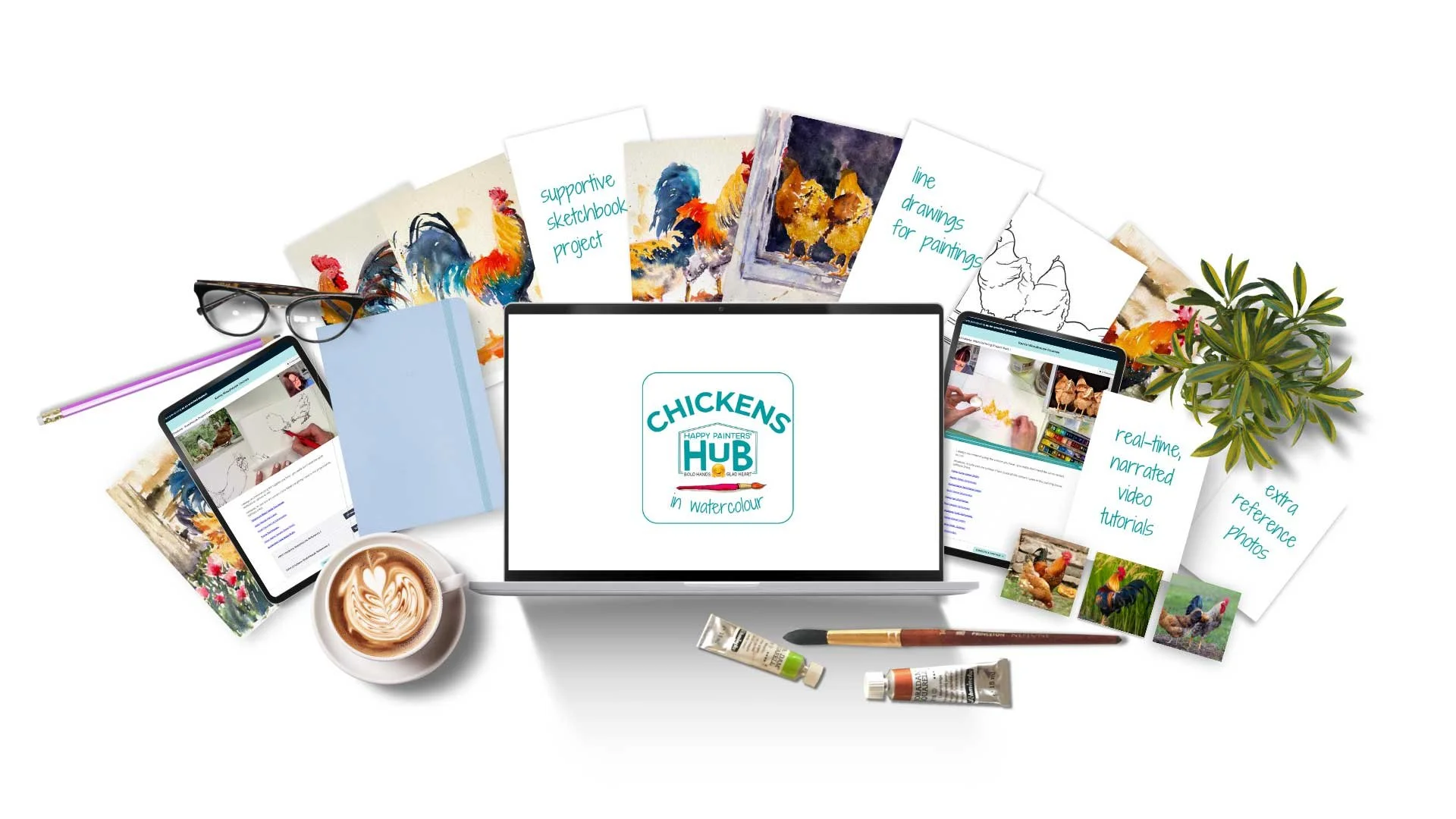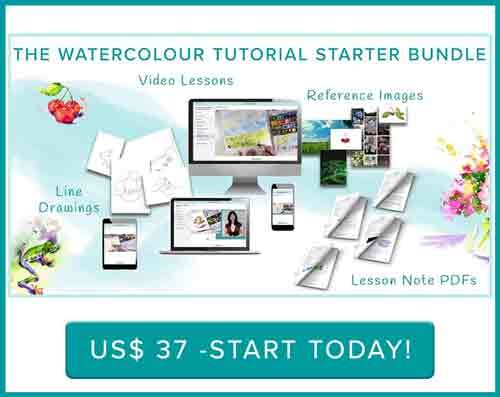Build Watercolour Confidence: One Brush, One Subject Exercise
This is not just a fun way to fill a page with watercolour. It's also a great way to know what your brushes can do.
If you've ever felt clumsy with a new brush or struggled to feel confident in your watercolour paintings, I have the perfect exercise for you. This simple challenge is going to make you feel so much more confident in your next watercolour painting, and honestly, it's more fun than you might expect.
The Challenge: One Brush, One Subject
The idea is beautifully simple: paint each subject with just one brush. All the shapes that you need to make, you need to come up with a way of doing it with that one brush.
I chose chickens for this exercise because they're simple enough to be manageable, but complex enough to be interesting. Plus, there's something delightfully low-pressure about painting chickens – they're not intimidating subjects that make you freeze up before you even start.
Watch me demonstrate this technique in the video below:
What You'll Need
Watercolour paper that can cope with a bit of water (I recommend 300gsm cold-pressed)
One brush – any brush will do, but try different ones to see what each can achieve
Basic watercolour paints – even just two colors like yellow ochre and burnt sienna will work
A reference photo with multiple similar subjects (chickens, birds, simple flowers, etc.)
Want to paint more splashy and spirited chickens with me?
Join Chickens in Watercolour and discover just how much fun loose expressive techniques can be with this spirited and joyful subject.
The Secret: Stop Thinking About Chickens
Here's the key insight that transforms this exercise: I need to stop thinking about chickens per se and rather just think about the shapes of color that I can see.
When you break it down even further to say "I'm not really painting a chicken, I'm just painting the color shapes that I can see in the chicken," everything becomes clearer. Then use that as your little challenge to see: can I represent those shapes in as few brush strokes as possible using only this one brush?
Discovering Your Brush's Personality
This exercise is fantastic for understanding what your brush can actually do. With my dagger brush, I discovered that:
When I turn it around, I can get more of a triangle shape
When I tip it on the very edge, I can get a fine line
The bristles split beautifully to create a dry brush effect for suggesting feathers
Every brush has its own personality and capabilities. A round brush makes this exercise easier in some ways, but it's the challenge of working with different brushes that makes you more versatile as an artist.
The Magic of Shape Recognition
This is where I'm starting to try and understand my brush a little bit more, but it's also where you develop crucial shape recognition skills. You're really taking advantage of looking for the big shapes of color you can see, rather than getting caught up in details.
I found myself getting better at:
Identifying the shapes in the bird
Making those shapes on the paper
Seeing which colors work well together as combinations
Why Repetition Works (But Keeps It Interesting)
What's quite nice about painting the same subject multiple times is that each one is a little bit different. There's enough familiarity that you feel increasingly comfortable with the next bird, but there's also enough of a tiny little change here and there to keep it interesting.
You automatically start trying out different things. For example, I didn't do quite as much dropping in of dark colour on the first chicken, but by the third one, I was experimenting with that technique because I was getting comfortable with the exercise.
The Art of Letting Go
One of the most valuable lessons this exercise teaches is letting go of detail. I'm really not worrying about articulating all the little details – even the eye I'm not going to worry about. I just want the main things that will make the subject recognisable.
My best advice is to not be thinking so much about the chicken and not be judging everything that you put down. Don't put a mark down and get disappointed if it doesn't instantly read as a chicken. You have to kind of trust the process and just keep placing the marks, looking for each color block, each shape.
Direct Painting: Braver Than You Think
Now just quietly, have you noticed we have been doing all of this painting with absolutely no sketching? That does feel awfully brave, doesn't it, but is it easier than you thought it might be?
Some people call this direct painting – painting directly with no drawing. When you're painting something a little bit smaller like this and something nice and simple, it's a great way to ease into that approach.
What You're Really Learning
Even if you don't end up with something magnificent at the end (because let's be honest, that wasn't really our goal in the first place), you still probably had quite a lot of fun and you've put in some very useful brush miles that are going to stand you in excellent stead going forward.
You're learning about:
Using your brush more effectively
Putting colours next to each other and how much they flow into each other
Building confidence with direct painting techniques
Seeing subjects as shapes rather than objects
Trusting your instincts as an artist
Embrace the Imperfect Results
If you're going to paint a whole series of the same thing, you can expect that some of them you're going to like better than others. Some will work out far better than you ever thought you could do, and some might be a complete disaster. That's okay. That's just how the creative process works.
Even the one that disappoints you will still have been something that you definitely learned from. Remember, whichever brush has been in your hand the most is the one you're going to feel a lot more comfortable using. So it's just a case of a bit more practice.
Ready to Try It?
This exercise is a low-pressure way to experiment, but don't underestimate how much it's actually offering you. It's a great way to spend a bit of time on an afternoon, filling a page with watercolour while building genuine skills.
Are you up for the challenge? Grab your brushes and give it a try. You might be surprised by how much more confident you feel with your watercolour painting afterward.
Ready to take your watercolour chicken painting further? Come and investigate Chickens In Watercolour. You can get the standalone course, or access this class plus a growing library of more than 20 other similar tutorials with a monthly membership.
Are you on your own painting journey?
One of these might be useful…











